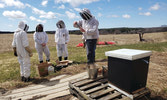By Lisa Boonstoppel-Pot
Beekeepers are reporting staggering losses as they open hives and discover colony after colony of bees dead.
“This is all across Canada,” reports Bernie Wiehle, owner of Wiehle’s Wildflower Honey near Rodney who spoke to members of the Ausable Bee Club on April 11. Wiehle is also president of the Ontario Beekeepers’ Association (OBA) which is collecting the data, a process that is still ongoing.
“We are seeing huge hive losses and we knew that going into winter, things were not going to be good,” said Wiehle. More than 520 beekeepers have responded to OBA’s winter loss survey so far and these submissions indicate that 53 per cent of beekeepers have lost more than 50 per cent of their colonies this past winter.
“It ranges from just a few colonies lost to 100 per cent loss for some beekeepers. It is spread across the whole province and across Canada,” said Wiehle. Western beekeepers were hit hard and Quebec has “been hammered”.
“We are hearing staggering losses in the United States too,” added Wiehle.
Of all the Canadian provinces, Ontario seems to have been hit the hardest but Wiehle admits since all the numbers aren’t in, reporting averages could be skewed.
What makes these losses even more challenging is that this spring has been slow with “goofy weather” which further stresses the bees and could lead to more colony deaths.
When beekeepers were asked the reasons for their colony deaths, three main reasons emerged:
• Colonies were too weak and small going into winter
• The fluctuation of weather this winter was stressful on the bees
• An overload of varroa mites in late summer.
Wiehle explained that these winter losses actually began last spring when the early warm weather created a bee population explosion. As bee numbers increased, so did the population of varroa mites, a parasite which sucks the fat bodies of bees, spreading viruses and weakening the bees so they cannot fight off the viruses.
“It was always our recom-mendation that if you didn’t have mites, you didn’t have to treat it in the spring,” said Wiehle. “Now we are thinking beekeepers should treat anyway.” Beekeepers traditionally treat for mites in the fall though experienced beekeepers do mite checks and treat as needed.
Beyond varroa mites, other reasons cited for winter hive deaths included problems with queens, starvation, suspected pesticide and fungicide poisoning and infestation of the small hive beetle (very few beekeepers reported this last one as a concern).
“We know we’ve had a real problem with farm sprays and we’ve been talking with the Ministry of the Environment to do studies and surveys with beekeepers to find out what is going on with fungicides and the bee population,” said Wiehle.
With so many colony collapses, there are concerns from fruit growers in Niagara and out east that there may be not enough bees for pollination services. Also, it may be difficult for beekeepers to source nucleus colonies (nucs) to replace their bees. Other beekeepers who plan to split hives may not have enough healthy hives to replace the hives they lost.
Inevitably, this year’s losses will force some beekeepers out of business, predicted Wiehle. Particularly hobby beekeepers. “It’s an expensive hobby if you have to keep buying nucs,” he said.
Not all beekeepers experienced tremendous losses. Bill Ferguson, of Ferguson Apiaries near Hensall, reported less than 6.5 per cent loss of his hives. He credits his bees’ survival with time-learned techniques of only using young, healthy queens. He treats all the hives in September after harvesting all the honey to remove any potential pesticide residues being eaten by the bees. Then he feeds all the hives a 1:1 sugar syrup so they can fill the hives with honey before winter.
Jonathan Cucksey is a newer beekeeper from Clinton who works in partnership with Adi Treasurywala, a beekeeper with decades of experience. They did a spring hive check and treatment on April 10 and discovered only eight out of 22 hives had died. Cucksey was pleased so many hives survived.
Treasurywala believes varroa mites linger in every hive and recognized that last year’s ideal conditions for bees also created ideal conditions for varroa mites. He treats his hives routinely. This spring, every hive was treated with mite strips, oxalic acid (also for mites) and given two pollen patties to start them off. Many of the colonies were thriving and will be split to replace hives that were lost. ◊

